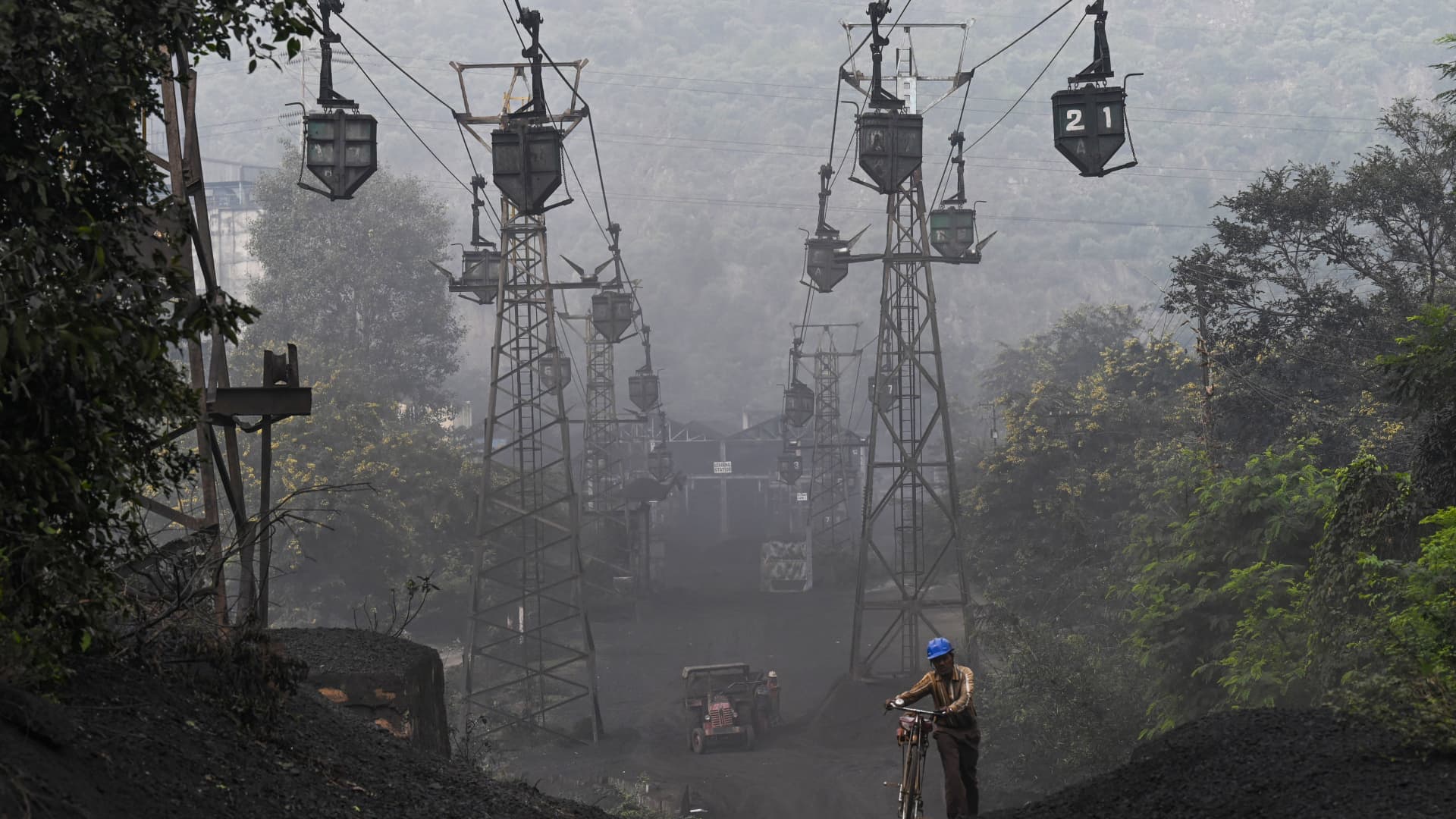There’s little doubt that India has made progress in its transition to renewable energy.
The country’s leaders have been optimistic about its path to net zero, making bold claims that 50% of its power generation will come from renewables by 2030, and 100% by 2070.
However, coal production continues to soar and reliance on the fossil fuel won’t end any time soon as India struggles to find other ways to cool homes down and keep the lights on.
“India will not be able to survive completely without coal and there is no alternative for India in the coming 10 to 20 years,” said Anil Kumar Jha, former chairman and managing director of Coal India — the world’s largest coal producer.
“If you are hungry and don’t have cake to eat, will you eat bread or die hungry? That is presently what India is doing,” Jha told CNBC. “We don’t have an alternative to generate that amount of electricity, and will have to depend on coal.”
Fossil fuels, mainly coal, continue to make up 75% of India’s power supply, making it “the only fuel that India has in relative abundance,” said Neshwin Rodrigues, electricity policy analyst at Ember, a global energy think tank.
Effects from climate change have triggered more than 700 heat waves in India over the past five decades, driving up electricity demand as more households purchase air conditioners.
“India is presently witnessing a rapid surge in electricity demand, driven by the electrification of numerous households, the burgeoning economy, and the increasing adoption of electric vehicles, infrastructure development, and cooling systems,” said Sooraj Narayan, Wood Mackenzie’s senior research analyst of power and renewables in Asia Pacific.
“This heightened power demand necessitates a reliable, cost-effective, and consistent power generation source, which coal currently fulfills,” he highlighted.
Whether we like it or not, coal will continue to have a role to play in India.Sooraj NarayanWood Mackenzie
Data from the International Energy Agency showed that electricity consumption in India from air conditioners increased by 21% between 2019 and 2022.
Nearly 10% of the country’s electricity demand comes from space cooling and this will increase ninefold by 2050, the IEA said.
Simultaneously, India’s coal consumption has rapidly increased.
The country’s coal production rose to 893 million tons in 2022 to 2023, a 14% growth from 778 million tons in 2021 to 2022, according to data from the Ministry of Coal.
Jha estimated coal production could reach 1,335 million tons in 2031 to 2032.
This raises the question about whether India will be able to reach its 2030 target of achieving 50% of its energy requirements from non-fossil fuel sources. As of now, energy analysts don’t think it’s achievable.
“Coal remains a reliable fallback option for India to ensure consistent and dependable power generation, especially as it strives to meet the demands of a rapidly growing population and economy,” Narayan pointed out.
This could be the norm for India until after 2030 — when coal demand is expected to peak, according to Sumant Sinha, founder of Indian renewable energy firm ReNew Power.
“What we cannot afford as a country is essentially to shortchange our growth on account of a lack of power capabilities. Whether we like it or not, coal will continue to have a role to play in India,” Sinha told CNBC’s “Squawk Box Asia” on last week.
Unreliable renewables
Despite being able to produce cheap wind and solar energy, only 22% of India’s power generation is met by renewables.
All the analysts who spoke to CNBC agreed the country’s solar, wind and hydro energy capabilities are still unreliable as they are dependent on weather conditions and the climate.
“Renewable sources like solar and wind are inherently variable, relying on natural factors such as sunlight, wind and water availability. This variability makes them less dependable for meeting the nation’s burgeoning power demand,” Wood Mackenzie’s Narayan said.
The South Asian nation currently has around 180 gigawatts of installed renewable energy, and hydropower makes up half of that mix. However, more advanced infrastructure is needed to ensure it serves as a reliable alternative to coal in the future.
India experienced the driest August in more than a century when it received 36% less rainfall. Coal reliance that month grew by 13% compared to the year before.
“While India seeks to leverage hydropower to balance its grid, this source of renewable energy is not without its complexities,” Narayan said, explaining that projects are often delayed.
“The construction of dams and run-of-river projects for hydropower often encounters prolonged delays, extensive gestation periods, and is contingent on variable rainfall patterns.”
Solar and wind energy face the same hurdles as underdeveloped power grids curtail progress in the sector.
“India’s existing grid infrastructure is not fully equipped to handle the integration of variable renewable energy sources like solar and wind,” according to Narayan.
Investment is key
Ramping up investments — particularly in battery storage — may be the most significant way for India to meet its net-zero transition goals.
India currently has around 180 gigawatts of installed renewable energy and aims to reach 500 gigawatts by 2030, according to government agency Invest India.
“Grid-scale battery storage is costly, with supply chain disruptions further driving up prices due to events like the Covid-19 pandemic and geopolitical conflicts. These complexities render it challenging to rely solely on renewables for consistent and dependable power generation,” Narayan said.
Another issue is that renewables are a frontloaded investment where “all your investments happen on the day of installation. You pay for everything upfront,” said Rodrigues from Ember.
“The problem with that is that you require a lot of financing capacity, and there is limited financing capacity in India,” he added, warning that India’s net-zero goals cannot be met without foreign investments.
“Going forward, we need to find ways to first phase down coal, then we can talk about completely phasing it out.”
— CNBC’s Naman Tandon contributed to this report.
